Fighting Back On The Ground 2: The Cross Armlock
By Eric Joseph
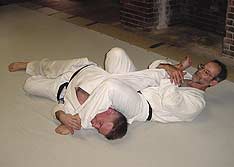
Editor’s Note: FightingArts.com is pleased to offer the second
in a series of articles on ground technique by Eric Joseph. Although
somewhat diminutive in size, Joseph is one of the most daunting grapplers
I have known, a person who combines tactical knowledge, superb technique
and lightening fast speed. Thanks also go out to Mike Hawley, another
fine judo-ka and superb aikido-ka, who assisted.
Even if you are a great puncher, it is also important to know basic
ground fighting techniques. Not only will this knowledge help make you
a better ground fighter, but it will also help you avoid techniques executed
on you.
This cross armlock is one of the most versatile and often used techniques
on the ground. Called juji -gatame in judo, it is classified as a kensetsu
waza (against the joint technique). It is also used in jujutsu and many
no-hold-barred full contact competitions, such as the UFC.
It can also be used on the street. But be careful. Your opponent might
have friends nearby who just might pounce on you, or kick you while you
are otherwise preoccupied. It is excellent, however, for one-on-one engagements.
Interestingly, those trained in wrestling often automatically turn so
that their back is up. Being belly up makes you vulnerable to being scored
upon in wrestling, but in real-world fights it is exactly where you want
to be. With your back up and an opponent lying on or across your body,
you are vulnerable to fist strikes, elbows, chokes, leg techniques,
or as here demonstrated, an armlock.
In the photo sequence that follows, the cross armlock is executed by
a person who is above and positioned across the opponent. The exact position
is not important. Many other starting positions are possible.
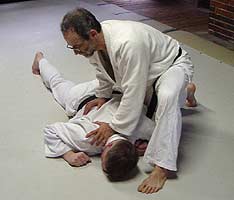 |
Photo1- Your opponent is face down. You are on top
and attack from the side at a 90 degree angle. |
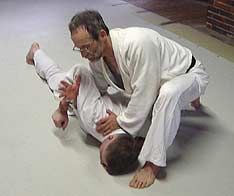 |
Photo 2- Dig your right fist and forearm down, between his ribs
and his upper arm, and force it under and up, so your open hand is
in the crook of his bent arm. |
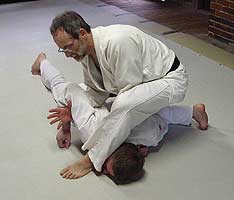 |
Photo 3- Continue to slide your right arm deep into your opponent’s
elbow joint and start to take out the slack. At the same time move
your left foot across his head. |
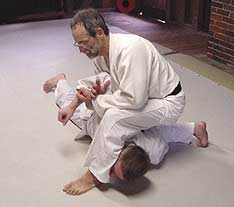 |
Photo 4- Pull the opponent’s elbow up to your chest and
hold it there. |
 |
Photo 5- Start to lie on your back as you take out the slack
of your partner’s arm. Your right foot is wedged under the opponent’s
side while your left lower leg pulls in the opposite direction against
the opponent’s head. Squeeze your knees together as tight
as you can. This is the key! |
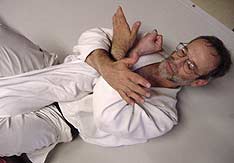 |
Photo 6- Lock partner's wrist to your chest and arch your stomach/abdomen
upward. Here I have crossed my arms over the opponent’s forearm
(holding his arm lower in yours gives you more leverage). Be sure
his elbow is facing downward. |
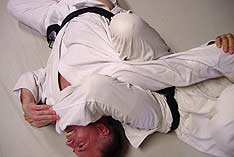 |
Photo 7- Make sure your heel is deep in your partner's neck
so he can't escape and that your right foot and lower leg presses
inward
so that the opponent’s body is angled upward. |
It is the upper pressure of your abdomen/stromach against the downward
pull on the wrist that creates opposing forces that can apply pressure
on the elbow of the opponent’s arm.
You need not be on the ground to execute this armlock. If you have thrown
your opponent onto his back (if on his stomach, you would just sink down
and proceed as shown above) this armlock can often be executed. The same
technique is available to a karate-ka or boxer who had blocked a punch
and either knocked, or tripped/swept the opponent to the ground --- if
you have the opponent’s right arm in yours and are standing by
his side.
If you are still holding the opponent’s right arm while he is
on his back on the ground, grasp the wrist with the other hand and pull
up quickly and sharply. Almost simultaneously drop down. Your buttocks
should land as close to the opponent’s side as possible, right
knee bent with the foot wedged under his body (his right side lifted
off the floor). At the same time the left leg should be placed over his
neck or shoulder. This should all be done very quickly so your opponent
does not have time to counter or try to escape.
As you drop down be sure to keep pulling his right arm. Also bring your
knees together strongly so you can hold his arm tightly between your
thighs. As noted above, and you can now refer back to photos 5 – 7
, to apply pressure against his elbow hold his arm to your chest (with
your hands or with your forearms crossed over his arm) straighten your
body and arch your back (which raises your abdomen).
If you are on the street and want to shock/strike your opponent, your
left heel can strike across the face/head as the foot is moved forward
over the opponent's head/shoulder. This can be a dangerous technique,
however, so if practiced it should be done in slow motion.
Defense Against This Armlock
Escaping from this armlock requires that you execute counter measures
before the armlock has applied pressure to your elbow.
1-If the person trying to execute this armlock on you has not positioned
himself up against you with his foot wedged tightly under your side,
you may be able to turn toward him and roll over or toward your outstretched
arm. As you do this, you can try to twist your hand and bend your elbow
to the side (outward) as you try to pull back with force. Try to grab
your own right wrist or sleeve to assist in the pull back. Try to draw
your own elbow down toward your right ribs (and between yourself and
your opponent).
2- If the armlock is almost in place, twist your body by lifting the
leg (closest to the opponent) and moving it up and over the other as
the body turns almost fully over. This places your body parallel to your
opponent and between his legs. This eliminates leverage on your arm.
With your little finger now facing upward, you can pull your hand free.
3- If the armlock is almost in place, use your left hand to grab your
opponent’s ankle (of his leg placed over your head/neck/shoulder)
and lift it upward so you can turn over (turning toward the leg that
had just been leveraged upward). This places you in a position as in
number 2.
A final note of caution: The techniques shown and explained above can
be very dangerous. Practice under supervision of a qualified instructor
and be careful not to put too much pressure on your opponent’s
elbow.
About the Author:
Eric Joseph has been a practitioner of judo since 1971. He is a 5th
Degree Black Belt, USJI, US5F (Kodokan), Certified National Referee,
Certified Kata Instructor, Certified Judo Coach, USA National Masters
Champion and Pan American Games Kata Champion. In Buffalo, NY he is affiliated
with the Kintora Martial Arts Center. He also teaches aikido at Bill
Adam’s Martial Arts and Fitness Center in Elma, NY. Other experience
includes Danzan ryu jujutsu.
|